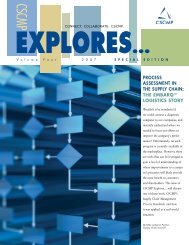Return Profits From Returns: Leveraging all 5 R's - Supply Chain ...
Return Profits From Returns: Leveraging all 5 R's - Supply Chain ...
Return Profits From Returns: Leveraging all 5 R's - Supply Chain ...
Create successful ePaper yourself
Turn your PDF publications into a flip-book with our unique Google optimized e-Paper software.
to products resold as is, sold for scrap/salvage, or donated. One study showed that recovery<br />
rates can easily exceeded 50%. xvii<br />
While stripping a product to its component parts to reuse or recycle sounds more expensive<br />
than purchasing new, this may not always be the case. The ability to efficiently reuse and<br />
recycle may emerge as a competitive advantage from a manufacturing / supply chain and<br />
marketing perspective. These practices will appeal to an audience that is especi<strong>all</strong>y<br />
environment<strong>all</strong>y friendly.<br />
Recovery Management<br />
In the old days, companies might simply just scrap the product, strip it for spares, or sell it to a<br />
liquidating firm. Progressive companies are taking a more aggressive approach to managing<br />
returns with a focus on recovery speed. Getting product back into the distribution pipeline and<br />
onto the sales shelf, especi<strong>all</strong>y for short lifecycle or seasonable product, can cut the amount of<br />
merchandise that has to be dispositioned.<br />
Kodak remanufactures their single use cameras after the film in the camera has been removed<br />
and developed. Over the past decade, the company has recycled more than 310 million<br />
cameras in more than 20 countries. xviii<br />
Best practice companies are not only getting product back into existing sales channels quicker –<br />
they are also turning to multiple channel options as ways to recover their assets. Some of these<br />
options include<br />
• Sell as new in existing channel<br />
• Sell at discount in own shop or through another outlet<br />
• Repair and resell as seconds<br />
• <strong>Return</strong> to supplier for credit<br />
• Sell at bigger discount into secondary market<br />
• Sell through online marketplaces such as eBay or Amazon.com<br />
• Refurbish, inspect, test, remanufacture, recycle, repackage, re-warranty<br />
• Strip for spares<br />
• Donate to charity<br />
• Scrap to a licensed agent<br />
• Develop global networks or partnerships with other companies that repair products and<br />
services " xix<br />
The Bottom Line on <strong>Return</strong>s<br />
The bottom line of any good returns management program should be to look across each of the<br />
five key elements that touch a return. Companies should seek opportunities to broaden their<br />
view of returns management as a strategic role for recapturing value, recovering assets, and<br />
improving customer loyalty. Companies that bring focus to their returns practices can achieve<br />
considerable benefits.<br />
6




